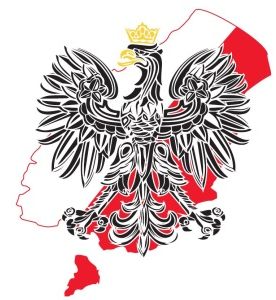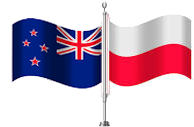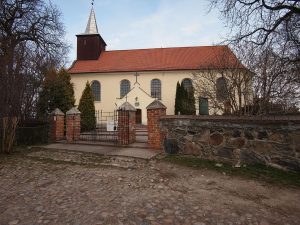Wiśniewski Family

click on name or picture to go to Wiśniewski Family Tree at ancestry.com

Click ship to open the Reichstag ship page
Spoken Polish
If you would like to hear the Polish names and text spoken in Polish then we can help.
Firstly click on this link "Text to Polish" and then copy the text you wish to hear, and paste it into the translation box. You can either listen to it or have it download onto your machine.
Enjoy !!
SURNAMES & THEIR ORIGINS
ORŁOWSKI (Rus) Orlov & (Pol) orzeł. Meaning: Eagle or descendant of one with eagle-like characteristics. From the nickname Oryol – eagle.
PAROBKIEWICZ (Pol) parobek. Meaning: Farmhand, hireling.
WIŚNIEWSKI (Pol) wiśnia. Meaning: Cherry-tree or wiśniak – cherry wine.
Michał Wiśniewski (b. 1835–d. 1911) was born at Mała Słońca, in April of 1835, the son of Franciszek Wiśniewski (b. 1799–d. 1852) and Maryanna Łęska (b. abt. 1798–d. bef. 1841). Michał of Wacmierz, married on 13 November 1859 at St. Jan Nepomuncen in Godziszewo to Anna Maria Orłowska (b. 11 August 1837 at Pszczołki–d. 1910), the daughter of Jozef Aleksander Orłowski (b. 1813–d. 1895) and Brigitta Parobkiewicz (b. 1814–d. 1906). The family born at Trzcińsk were: Jozef (b. 1860–d. 1860), August (b. 1861–d. 1942), Franciszek (b. 1863–d. 1863), at Gniszewo; Jan (b. 1866–d. 1866), at Małe Turze; Franciszka (b. 1867–d. 1867), Waleria (b. 1869–d. 1869), Antoni James (b. 1871–d. 1950) and Bernhard (b. 1873–d. 1947). They left the village of Turze Wielkie for Hamburg where they set sail aboard the Reichstag on 10 May 1874, arriving at Port Nicholson in Wellington on 6 August 1874. The family had been nominated by family and friends in Waihola to settle there in New Zealand.
Listed aboard were: Michael Wischniewski age 37, Anna 37, August 12, Anton 3 and Bernard 11 months. They were sent to Soames Island for isolation before being sent to Dunedin where they were sent to the western compartment of the Caversham Immigration Barracks. From here they walked the rest of the way to Waihola where members of Annie’s family had settled two years prior. On a small allotment which was made ready for them, Michael built a clay cottage with his bare hands. He later built a wooden one and used the original home as a store. Here they had the rest of the family which were: Martha (b. 1875), Francis (b. 1877), Anna (b. 1878–d. 1955) and James (b. 1880). According to the 1882’ Return of Freeholders, Michael owned five acres to the value of £100 at Waihola. While employed as a labourer, Michael was naturalised as a New Zealand citizen on 13 June 1887. Considered a real leader in the Waihola Community, he was devoted to his faith and took much liberty in ringing the church- bell on special occasions such as funerals, etc. Their home was always open to visiting priests who would be welcomed in for breakfast and where all church meetings were held. Michael would read extracts from the bible, being able to read only in Polish. When they needed a letter written in German or English, they would ask Mr. Hilgendorf, a businessman at Waihola for help and grandson, Hyacinth, remembered two such occasions.

Michael Wisniewski, Anna Maria (nee Orlowska) and adopted grandson Alexander/Alec. Ca. 1908, courtesy of Charlotte Olsen at ancestry.com
Annie allowed no physical work on Sundays and this was very strictly observed. She was the local midwife for Waihola and was naturalised as a New Zealand citizen on 16 November 1899. Their daughter, Anne, was the church organist and washed all the altar linen and cleaned the church. She was extremely upset when the church was moved to Broad Bay near Dunedin in 1948. She was also the local dressmaker, staying at people’s places sewing their winter and summer wardrobes. She is also remembered with huge scissors in hand being able to cut without a pattern.
“Fire at Momona. A hard case. On Tuesday night one of the Momona settlers, Mr. Wisnesky, suffered a severe loss through the burning of his house. The fire took place at 9 o’clock, and nothing is known as to the case of it. Mr. Wisneski and his wife were outside at the time, and the first intimation they had of the fire was the sight of the flames. The house was a small one, and was quickly consumed, not even a particle of furniture being saved. Mr. Wisneski’s case is a particularly hard one. He is an industrious settler, who had taken up a section in Momona, and his past savings had been invested in the building of his house and the purchase of cows. Ł5 1s 6d in cash was in the house. There was not a shilling of insurance on his property, and Mr. & Mrs. Wisneski saved nothing but the clothes they were wearing. The loss is estimated at Ł160. From what we know of the people round about Mr. Wisneski’s neighbourhood we feel sure that they will have great sympathy with him in his misfortune and assist him to the best of their ability in making a fresh start.” The Taieri Advocate, 10 February 1900
“MARRIAGE. GOLDEN WEDDING. WESNESKY-ORLOWSKI. On November 9, 1858, at the Parish Church, Oboyene, Prussia, by the Rev. Father Whaltar, Michael Wesnesky, of Soubkou, Germany, to Anne Orlowski, of Bouarghin, Germany. Present address: Waihola, Otago, New Zealand.” Otago Daily Times, 09 November 1908, p 4
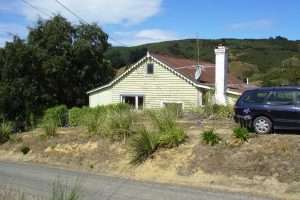
Wisnesky Cottage at Waihola in 2015, courtesy of Paul Klemick
“Golden Wedding. Mr and Mrs M. Wisnesky had the pleasure of celebrating the anniversary of their wedding, which took place 50 years ago, Monday, November 9th, The elements were not too kind during the early part of the day, but in the afternoon the weather, though a trifle windy, was the finest we had had for nearly a fortnight. Early in the afternoon streams of people and vehicles were seen winding their way up and down the hill, for “The Firs;” the home of the old couple stands on a small flat half-way up Waihola hills, thus commanding an extensive view of the lake, the Taieri River, and all the surrounding country. Nearly fifty guests had assembled at the invitation of the host and hostess to offer their congratulations to the long wedded couple, and to partake of the excellent luncheon that had been provided. Three long tables groaned beneath a weight of good things, and the greatest epicurean could not but be satisfied, In the unavoidable absence of Father Farthing, Mr Hilgendorf proposed the continued health of the couple, and very enthusiastically eulogised Mr and Mrs Wisnesky for their energy, perseverance, arid, hard grit, when first they came to these parts arid made their home among us. He said it was characteristic of most his countrymen to be good settlers, and he ventured to say that no one would have made as comfortable a home out of so little and such poor country as the stock represented by host and hostess. Thirty four years ago, they had, with a number of. others, found their way to Waihola, and endured great hardships – at first, but he was pleased to say they were now in very, comfortable circumstances, and deserved everything they had got. Mr A. Wisnesky responded on behalf of his parents. Mr and Mrs Wisnesky have still near them ‘four children, of whom the three. sons, are married, 12, grandchildren and one great .grandchild.. The guests hailed from Dunedin, Berwick and Milton, but many others unable to be present sent congratulatory letters, and in many instances photos to remind them of absent friends. Numerous presents were showered on the worthy pair, and a number of gold coins. In the evening a large crowd of young people assembled in the hall, to trip the light fantastic and all went merrily until the party broke up about 3 a.m.” Bruce Herald, 16 November 1908, p 6
It is believed at the age of 70 Michael worked on the Mosgiel-Middlemarch railway to make ends meet while raising their grandchild. Michael later sold the property at the Momona Estate to his son Bernard in 1904. Annie died at Waihola on 25 December 1910 aged 73 and is buried at the Waihola Cemetery.
“Waihola. (From Our Own Correspondent). Since my last letter, two of our early settlers have passed to their rest, Mrs Carl Henke, senr., and Mrs M. Wisnesky. They both had been in delicate health for some considerable time; but had been confined to bed for a few days only, before the end.” Bruce Herald, 30 January 1911, p 5
Michael died at Waihola on 24 December 1911 aged 75 and is buried with his wife at the Waihola Cemetery.
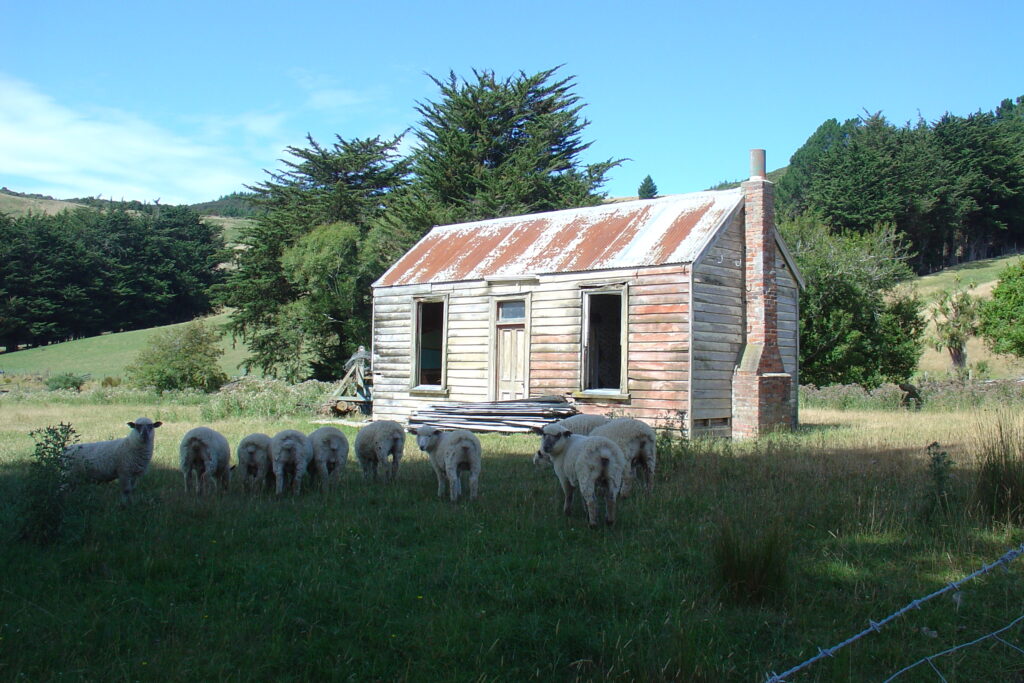
Annie Wisnesky (church organist) lived in this cottage at Waihola and was later sold to Julius Bungard, courtesy of Paul Klemick, 2015
August Wisnesky was born at Trzcińsk on 22 December 1861. At fourteen, he went to Milton and was apprenticed to a man named Chisolm who taught him carpentry. After completing his apprenticeship, it appears that he moved to Dunedin where he married on 22 January 1884 at Knox Church to Wilhelmina Henke (b. 1861–d. 1945). Ousted from the family because his wife was German and of a different faith, they left New Zealand and settled in Melbourne, Australia. Here August worked in a sash and door factory in Northcote. The family returned to New Zealand in 1894 and settled in Dunedin. Here August worked for the New Zealand Railways, eventually being appointed as superintendent of the Hillside Workshops. The family were: Eva Lily (b. 1884–d. 1958), Augustus Henry Francis (b. 1886–d. 1966), Henry Raymond (b. 1886–d. 1912), Victor Daniel (b. 1892–d. 1977), Bernard Anton Frederick (b. 1895–d. 1967), Gladys Nellie Amelia (b. 1901) and Alexander Ross (b. 1905–d. 1981). August died at Dunedin on 14 May 1942 aged 80 years.
“DEATHS. WISNESKY.—On May 14. 1942, at his residence, 29 Playfair street, Caversham, Augustus, dearly loved husband of Minnie Wisnesky: in his eighty-first year. “At rest.” No flowers, by request.—The Funeral will leave the Caversham Presbyterian Church To-morrow (Saturday). May 16, at 1.30 p.m., for the Anderson’s Bay Cemetery. (Service at 1 p.m.).—C. J. Thorn, Ltd., funeral directors.
FUNERAL NOTICES CAVERSHAM PRESBYTERIAN CHURCH.—The Office-bearers of the above Church are requested to attend the Funeral of their late fellow office-bearer. A. Wisnesky. which will leave the Church at 1.30 p.m. To-morrow (Saturday), May 16. for the Anderson’s Bay Cemetery. (Service at 1 p.m.).—J. Lock, Session Clerk.
HIRAM LODGE, No. 46.—The Brethren of the above Lodge are respectfully requested to attend the Funeral of their late Bro. A. Wisnesky, which will leave the Caversham Presbyterian Church To-mor-row (Saturday), May 16, at 1.30 p.m., for the Anderson’s Bay Cemetery. (Service at 1 p.m. ). By Order W.M.” Otago Daily Times, 15 May 1942, p 1
Wilhelmina died at Dunedin on 16 May 1945 and is buried with her husband at the Andersons Bay Cemetery in Dunedin.

Anthony Wisnesky, courtesy of Gordon John Greaney at ancestry.com
Anthony James Wisnesky was born at Małe Turze on 29 April 1871. He was employed as a labourer and married on 15 August 1900 at St. Hyacinth in Waihola to Margaret Tarbet (b. 1875–d. 1964). The family were: Jeannie Glady (b. 1896–d. 1991), Myra Valeria (b. 1901–d. 1991), James Walter (b. 1903–d. 1927), George Lambert (b. 1904–d. 1972), Anne Margaret (b. 1905–d. 1982), Michael Francis (b. 1907–d. 1973) and Ida Veronica (b. 1908–d. 1998).
“Milton Police Court. Tuesday, December 30, 1902. (Before Messrs A. Nelson and Robert Murray, J.P’s. Alleged Theft. — Anthony Wisnesky was charged on the information of William Smith (Waihola) with stealing one screw wrench of the value of 6s 6d, on or about September 29. — Accused, for whom Mr Paterson appeared, pleaded “Not Guilty.” Constable MacKae stated that Smith was a farmer residing at Waihola. The wrench in question was purchased by Smith with a Deering Binder. One morning after complainant’s sons had been using the wrench Wisnesky came to borrow some blades for disc harrows. Accused on his way home took a different road to the boys, which led him past the stable where complainant’s sons had been using the wrench. A quarter of an hour afterwards the boys returned and the tool was missing. Mr Smith, senior, next day charged Wisnesky with taking the wrench, but he denied it. Nothing farther was heard of the matter till 9th December, when Smith saw the wrench in the possession of one Frank Henke. The latter said he got the wrench from Wisnesky, and an argument taking place later between Smith and Wisnesky as to ownership, Henke said he would keep possession of the tool till the police called for it. Constable MacRae further stated that when he interviewed Wisnesky he said he had obtained it from his brother in Henley, but was willing to give it up if Smith said it was his. Smith said he only wanted his own and Wisnesky then said, “Well, I will say it is yours if that will satisfy you.” — Evidence was given by William Smith Senr., W. Smith junr, and Alfred Smith. — Mr Paterson for the defence, submitted that there was no case to answer. He proposed to put in a defence simply to clear his client’s character completely. The evidence for the prosecution was most vague and purely circumstantial. Smith at first was uncertain about the wrench and then he said it was his. There was no evidence whatever that he had been seen carrying it away. A witness— a boy also named Smith— would give evidence and say he saw all Wisnesky did on the day it was represented he took the wrench. His client would say the wrench was his, and would indentify it by a mark on the screw which had not been noticed by the prosecution. It would be shown that the story that he got the wrench from his brother was the true version. Another witness named Redmond would say Wisnesky called at his house when he was carrying the disc blades. He was not wearing a coat and it would be impossible for him to conceal a wrench about his person. He produced testimonials Wisnesky had reoeived from employers of his, and said that if convicted he would have a stain placed on his character which he might never be able to blot out. — Evidence for the defence was given by Anthony Wisnesky, Alfred Smith, “Albert Redmond and Bernard Wisnesky, — The bench dismissed the information, Mr Nelson remarking that it was a trival case and should never have beeu brought before the court —Each party was ordered to pay their own costs, ; the wrench to be returned to Frank Henke.” Bruce Herald, 6 January 1903, p 5
“CASUALTIES. OAMARU. December 8. A serious accident occurred in Oamaru this afternoon, when Anthony James Wisnesky, an employee of the Oamaru Borough Council, was knocked down by a motor car. It appears that Wisnesky, who was filling in some potholes in the road in Coquet street, saw a car coming towards him. and he stepped to one side to dodge it. The driver of the car, a man named Clarke, of Eden street, swerved to the same side. Both appeared to get confused, and Wisnesky was knocked down, the wheels passing over his feet. The injured man was removed to hospital, but the extent of his injuries cannot be ascertained until an X-ray examination has been made. It is understood he received injuries to his back, besides a broken ankle and abrasions.” Otago Witness, 15 December 1825, p 37
Anthony died at Oamaru on 10 June 1950 aged 79.
“DEATHS. WISNESKY.—On June 10. 1950, at Oamaru, Anthony James, beloved husband of Margaret Wisnesky, 70 Humber street Oamaru; in his eightieth year. R.I.P.— Requiem Mass at the Basilica, Reed street, Oamaru. Today (Monday), June 12, at 9 a.m.—Private interment. —Stringer and Wilson, funeral directors, Oamaru.” Otago Daily Times, 12 June 1950, p 1
Margaret died at Oamaru on 18 November 1964 and is buried with her husband at the Oamaru Old Cemetery.
Bernard Wisnesky was born at Małe Turze on 14 June 1873.
“LOCAL AND GENERAL A serious accident happened last week to a young man named Bernard Wisneski, one of the platelayers employed in laying the permanent way between Hyde and Capburn, through one of the heavy rails falling on and crushing one of his ankles so severely that he had to be sent to his home at Waihola by last Wednesday’s, 13th inst, 5.45 a.m. train.” Mount Ida Chronicle, 22 January 1897, p 3
Bernard married on 7 December 1898 at the Wisnesky Home in Waihola to Henrietta Kay (b. 1875–d. 1905). The family born at Waihola were: Cedric William Kay (b. 1898–d. 1944), Hyacinth Francis (b. 1900–d. 1989) Cecilia Evelyn (b. 1901–d. 1996) and Ada Katarzyna (b. 1905). Hyacinth was the first child to be baptised at the church of St Hyacinth at Waihola and recalls his grandparents, father and Aunt Anna (unmarried), looking after his sister and himself after the death of their mother while giving birth to Ada Katarzyna on 9 May 1905. The small farm his grandparents owned in Waihola could not keep the family, therefore his grandfather worked for the railways on the line up to Middlemarch. In 1907, when his grandfather was about 70 years of age, Hyacinth stayed at home looking after the 200 chickens and chopping firewood for him. Aged around ten years of age, he used to drive a horse-cart or sledge for his grandfather, collecting firewood or cutting ripe grass for grass-seeds. Hyacinth also helped August Orlowski by holding the ladder for him when he was doing repairs to the church. While at home in Waihola the old people including his father and Aunt Anna, used the Polish language. Between themselves, they spoke about Poland but never to Hyacinth. Henriette, at the age of 30, died at the home of Annie Wisnesky on 9 May 1905 and is buried at the Waihola Cemetery.
“Magistrate’s Court. (Before Mr Acheson, S.M.) BREACHES OF BY-LAWS. Bernard Wisnesky and Annie Lilburne were charged with allowing cattle to wander, and William Ship was similarly charged regarding a horse. The a first defendant pleaded guilty, and was fined 5s without costs. —Ship did not appear and was fined 5s and costs. —Annie Lilburne, against whom were numerous convictions, was fined 20s and costs.” Bruce Herald, 22 November 1915, p 5
Bernard died at Petone in Lower Hutt on 15 June 1947 aged 74 and is buried at the Taita Old Cemetery.

Augustus and Wilhelmina Wisnesky, Block 148 Plot 61 at Andersons Bay Cemetery in Dunedin
References
Pobόg-Jaworowski, J. W, History of the Polish Settlers in New Zealand, ed. Warsaw; Chz “Ars Polonia.” 1990, pages 42, 45, 46, 47, 155, 172 & 196.
Research Sources
Archives New Zealand, Passenger Lists, 1839-1973, FamilySearch.
Archives New Zealand Te Rua Mahara O Te Kawanatanga; Land Records.
Catholic Diocese of Dunedin, St Mary’s Church, Milton; Baptism Register.
Godziszewo, Miłobądz & Subkowy Parish Records, Pelplin Diocese, Poland.

Anthony James and Margaret Wisnesky, Catholic Block 170 Plot 15/16 at Oamaru Old Cemetery
New Zealand Department of Internal Affairs Naturalisations, Births, Deaths and Marriages.
New Zealand Government Property Tax Department, from the rates assessment rolls, Return of Freeholders of New Zealand 1882, published 1884.
Waihola Cemetery Records, Dunedin Public Library
Websites
Andersons Bay Cemetery – Augustus Wisnesky (1861-1942) – Dunedin City Council
Archway.archives.govt.nz.
Oamaru Old Cemetery – Anthony James Wisnesky (1869-1950) – Waitaki District Council
Taita Old Cemetery – Bernard Wisnesky (1873-1947) – Find A Grave Memorial
Waihola Cemetery – Anna Maria Wisnesky (1837-1910) – Find A Grave Memorial
Waihola Cemetery – Michael Wisnesky (1835-1911) – Find A Grave Memorial
Compiled by Paul Klemick (2024)
Chairperson ..... Ewa Rożecka Pollard
Phone ......+64 3 477 5552
Secretary ..... Anna McCreath Munro
Phone ..... +64 3 464 0053
Facebook ..... Poles Down South
Contact Poles Down South
Poles in New Zealand We would like to hear from Poles or people with any Polish connection, who visited New Zealand and particularly those of you who paid a visit or lived anywhere in Otago or Southland.
....................
Polski “Poles Down South” jest stroną internetową organizacji polonijnej w Nowej Zelandii działającej w rejonie Otago i Southland na Wyspie Południowej. Siedzibą organizacji jest Dunedin.
